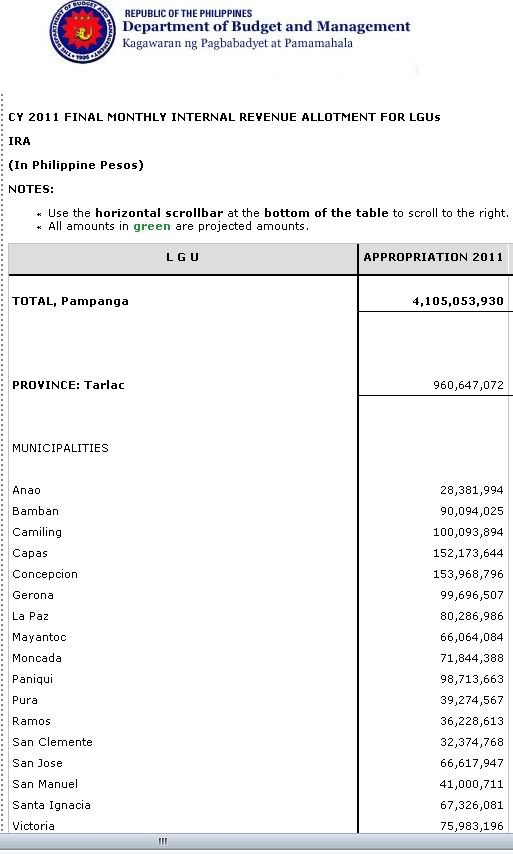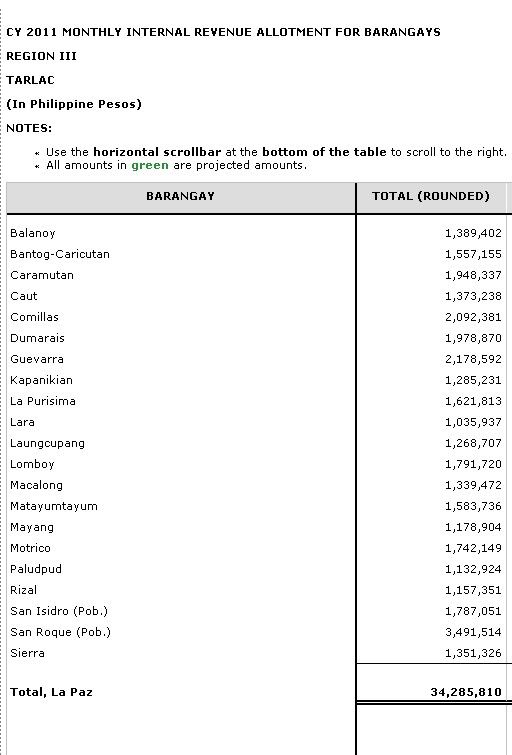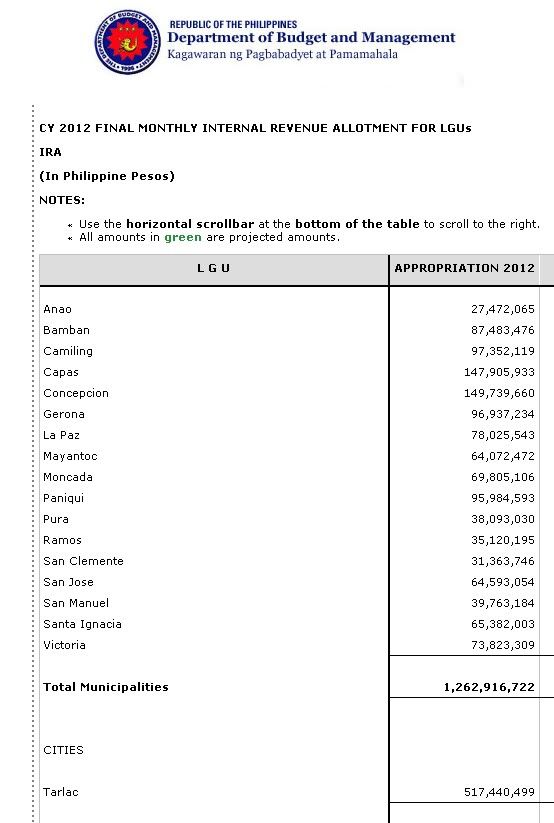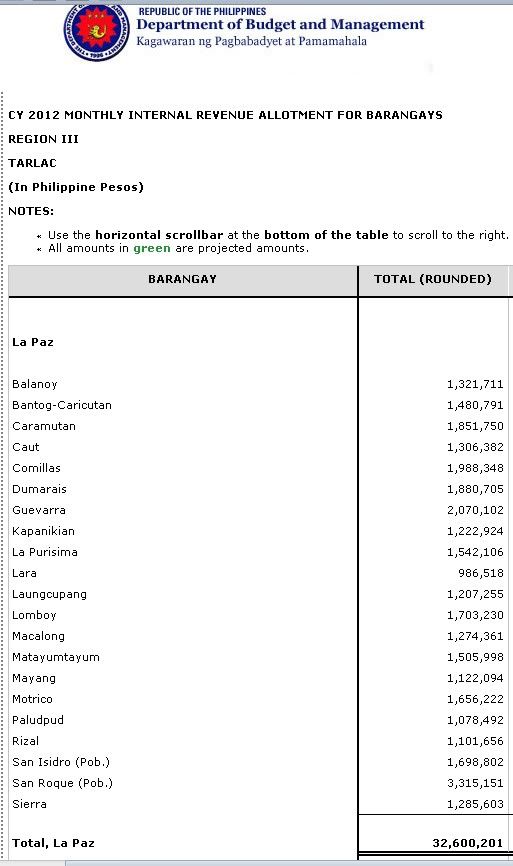Post by Louie Policarpio on Oct 18, 2010 17:27:23 GMT -8
Malapit na naman ang Barangay election. Hopefully yung mga kandidato ay may knowledge on this.
II.
Sources of income of the barangay
1. What are the sources of income of a barangay from the exercise of its taxing powers?
Barangays are authorized to generate income from taxes on stores or retailers with fixed business establishments and gross sales or receipts in the preceding year of P50,000 or less in cities and P30,000 or less in municipalities at the rate not exceeding one percent (1%) on such gross sales or receipts.
2. What are the sources of income of a barangay from the exercise of other revenue-raising powers?
A barangay can also collect income from the following:
Service fees or charges for the use of barangay property or facilities;
Barangay clearance fees;
Fees or charges for the commercial breeding of fighting thingys and on thingypits and thingyfights;
Fees or charges on places of recreation with admission fees;
Fees or charges for billboards, sign boards, neon signs and other outdoor advertisements;
Toll fees or charges for the use of any public road, pier or wharf, waterway, bridge, ferry, or telecommunications system funded and constructed by the barangay;
Revenues from the operation of public utilities and barangay enterprises (markets, slaughterhouses, etc.);
Fines (not exceeding P1,000) for the violation of barangay ordinances; and,
Proceeds from the sale or lease of barangay property or from loans and grants secured by the barangay government
3.How are conflicts or tax issues resolved?
Conflicts or tax issues that may arise between a barangay and its mother municipality or city from the exercise of its taxing power shall be resolved at the local level. Unresolved cases may be referred to the DOJ.
4.Is there a need for a public hearing when a new revenue measure is enforced?
Yes. Under Section 187 of the Local Government Code of 1991 (RA No. 7160), public hearing shall be conducted before a new revenue measure/tax ordinance is enacted.
5.What are the shares of a barangay from national/provincial/city or municipal revenues?
A barangay is entitled to a share from the following revenues:
Real property tax (RPT) collections of the province and city;
Community tax collections when collected by the barangay;
Internal revenue collections;
The development and utilization of the national wealth;
The proceeds of tax on sand, gravel, and other quarry sources; and,
Tobacco excise tax pursuant to RA No. 7171.
6.What funding support does a barangay receive from provincial/city or municipal governments?
A barangay is entitled to a mandatory financial aid of not less than P1,000.00 from the provincial and city/municipal governments where the barangay is located.
Likewise, a barangay is also entitled to receive voluntary donations, grants or aids from any public or private entity. However, the amount of donations, grants or aids received shall not be included in the budget. Disbursement therefrom shall not be made except for the purposes from which they are intended.
7.How much is the share of a barangay out of the proceeds from real property tax (RPT)?
In the case of provinces, twenty-five percent (25%) of the proceeds from RPT collections of the province shall accrue to the barangay where the property is located.
In the case of cities and municipalities within the Metropolitan Manila Area, thirty percent (30%) of the proceeds shall be distributed among the component barangays within the city/municipality where the property is located, as follows:
50% to the barangay where the property is located; and,
50% to be distributed equally among all component barangays of the city/municipality.
8.How much is the share of a barangay within a province/highly urbanized or independent city out of the proceeds from the development and utilization of national wealth?
A barangay is entitled to thirty-five percent (35%) of the forty percent (40%) share of the province or highly urbanized or independent component city where it belongs. If the natural resources are located in two (2) or more barangays, their respective shares should be computed on the basis of:
a. Population - Seventy percent (70%)
b. Land area - Thirty percent (30%)
9.Is the collection of community tax per barangay subject to deputation by the Municipal/City Treasurer?
Yes. Pursuant to RA No. 7160, the City or Municipal Treasurer shall deputize the Barangay Treasurer to collect the community tax in their respective jurisdiction, provided that said Barangay Treasurer is bonded.
10. What are the institutions that can grant loans to barangays?
All financial institutions can grant loans to barangays, subject to their existing guidelines and requirements.
11.What is the Internal Revenue Allotment?
The Internal Revenue Allotment (IRA) is the annual share of local governments out of the proceeds from national internal revenue taxes. It is estimated at forty percent (40%) of the actual collections of national internal revenue taxes during the third fiscal year preceding the current year, as certified by the Bureau of Internal Revenue (BIR).
12.What constitute the National Internal Revenue Taxes being used as bases for the computation of IRA?
The following are deemed as national internal revenue taxes:
Income tax
Estate tax and donor’s tax
Value-added tax
Other percentage taxes
Taxes imposed by special laws, such as travel tax
13.What percentage of the total IRA goes to barangays and how is it divided among barangays?
Barangays get 20% of the total IRA which is divided among each one of the 41,882 barangays based on the following fomula:
a. Population - 60%
b. Equal Sharing - 40%
Note:
If the barangay has a population of not less than 100 the share should not be less than P80,000 per annum. The amount shall be chargeable against the 20% share of the barangays from the total IRA, and the balance to be allocated on the basis of the formula.
Illustrative example of how the IRA is computed (for CY 2000):
Step 1:
Compute the Net IRA
1997 National Internal Revenue
Tax Collection as certified by the
Bureau of Internal Revenue (BIR) P 304.440B
x 40%
IRA for CY 2000 P 121.778B
Less: Actual Cost of Devolved
Functions & City-funded
hospitals 6.539B
Unprogrammed Amount 10.000B
Local Government Service
Equalization Fund 5.000B
Sub-total 21.539B
Net IRA
P 100.239B
==========
Step 2: Allocate the Net IRA (P100.239 B) per
Section 285 of R.A. No. 7160
Share per LGU:
Provinces (23%) P 23.055B
Cities (23%) 23.055B
Municipalities (34%) 34.081B
Barangays (20%) 20.048B
P 100.239 B
==========
Step 3:
Allocate the aggregate barangay share of P20.048B to all barangays based on population (60%) and equal sharing (40%).
Equal Sharing = (P20.048B x 40%) divided by total no. of barangays
Population = (P20.048B x 60%) x the ratio of a barangay population to total Phil. population
Hence, the IRA share of a barangay is the sum of the following:
Share based on equal sharing; and
Share based on population.
14.What census of population is used as basis in computing the IRA share of the barangay?
The latest census which is updated every 5 years by the NSO shall be used as the basis for IRA computation. The figures as certified by the NSO are considered final.
15.Does a barangay created after the implementation of RA 7160 have a share in the IRA allocation?
No. Pursuant to Section 295 of the Local Government Code of 1991, a barangay shall derive its income from the parent LGU. However, the creation of a barangay must take into consideration the economic and financial viability of the barangay to be created.
16.Can the government or Congress outrightly decide on how much IRA share can be given in a year?
No. Section 284 of the Local Government Code of 1991 prescribes the amount of IRA to be allocated during a given year, i.e., 40% of the national internal revenue taxes based on the collection of the third fiscal year preceding the current fiscal year.
17.What causes the changes in the computation of IRA shares of the barangays?
The changes between the final and the tentative IRA shares of barangays are due to the following:
adoption of the new policy on land area every three (3) years;
adoption of the most recent population count conducted by the National Statistics Office every five (5) years;
conversion of municipalities into component cities after having been ratified in a plebiscite pursuant to Section 10 of the Local Government Code of 1991 (R.A. No. 7160);
creation of municipalities under existing laws;
official list of barangays submitted by the National Barangay Operations Office of the DILG; and
the allocation of Local Government Service Equalization Fund (LGSEF) for the funding requirements of projects and activities arising from the full and efficient implementation of devolved functions and services of LGUs pursuant to R.A. No. 7160.
Copyright © 2004 Department of Budget and Management ALL RIGHTS RESERVED
Source:www.dbm.gov.ph/dbm_publications/primer_on_brgy/b2.htm
II.
Sources of income of the barangay
1. What are the sources of income of a barangay from the exercise of its taxing powers?
Barangays are authorized to generate income from taxes on stores or retailers with fixed business establishments and gross sales or receipts in the preceding year of P50,000 or less in cities and P30,000 or less in municipalities at the rate not exceeding one percent (1%) on such gross sales or receipts.
2. What are the sources of income of a barangay from the exercise of other revenue-raising powers?
A barangay can also collect income from the following:
Service fees or charges for the use of barangay property or facilities;
Barangay clearance fees;
Fees or charges for the commercial breeding of fighting thingys and on thingypits and thingyfights;
Fees or charges on places of recreation with admission fees;
Fees or charges for billboards, sign boards, neon signs and other outdoor advertisements;
Toll fees or charges for the use of any public road, pier or wharf, waterway, bridge, ferry, or telecommunications system funded and constructed by the barangay;
Revenues from the operation of public utilities and barangay enterprises (markets, slaughterhouses, etc.);
Fines (not exceeding P1,000) for the violation of barangay ordinances; and,
Proceeds from the sale or lease of barangay property or from loans and grants secured by the barangay government
3.How are conflicts or tax issues resolved?
Conflicts or tax issues that may arise between a barangay and its mother municipality or city from the exercise of its taxing power shall be resolved at the local level. Unresolved cases may be referred to the DOJ.
4.Is there a need for a public hearing when a new revenue measure is enforced?
Yes. Under Section 187 of the Local Government Code of 1991 (RA No. 7160), public hearing shall be conducted before a new revenue measure/tax ordinance is enacted.
5.What are the shares of a barangay from national/provincial/city or municipal revenues?
A barangay is entitled to a share from the following revenues:
Real property tax (RPT) collections of the province and city;
Community tax collections when collected by the barangay;
Internal revenue collections;
The development and utilization of the national wealth;
The proceeds of tax on sand, gravel, and other quarry sources; and,
Tobacco excise tax pursuant to RA No. 7171.
6.What funding support does a barangay receive from provincial/city or municipal governments?
A barangay is entitled to a mandatory financial aid of not less than P1,000.00 from the provincial and city/municipal governments where the barangay is located.
Likewise, a barangay is also entitled to receive voluntary donations, grants or aids from any public or private entity. However, the amount of donations, grants or aids received shall not be included in the budget. Disbursement therefrom shall not be made except for the purposes from which they are intended.
7.How much is the share of a barangay out of the proceeds from real property tax (RPT)?
In the case of provinces, twenty-five percent (25%) of the proceeds from RPT collections of the province shall accrue to the barangay where the property is located.
In the case of cities and municipalities within the Metropolitan Manila Area, thirty percent (30%) of the proceeds shall be distributed among the component barangays within the city/municipality where the property is located, as follows:
50% to the barangay where the property is located; and,
50% to be distributed equally among all component barangays of the city/municipality.
8.How much is the share of a barangay within a province/highly urbanized or independent city out of the proceeds from the development and utilization of national wealth?
A barangay is entitled to thirty-five percent (35%) of the forty percent (40%) share of the province or highly urbanized or independent component city where it belongs. If the natural resources are located in two (2) or more barangays, their respective shares should be computed on the basis of:
a. Population - Seventy percent (70%)
b. Land area - Thirty percent (30%)
9.Is the collection of community tax per barangay subject to deputation by the Municipal/City Treasurer?
Yes. Pursuant to RA No. 7160, the City or Municipal Treasurer shall deputize the Barangay Treasurer to collect the community tax in their respective jurisdiction, provided that said Barangay Treasurer is bonded.
10. What are the institutions that can grant loans to barangays?
All financial institutions can grant loans to barangays, subject to their existing guidelines and requirements.
11.What is the Internal Revenue Allotment?
The Internal Revenue Allotment (IRA) is the annual share of local governments out of the proceeds from national internal revenue taxes. It is estimated at forty percent (40%) of the actual collections of national internal revenue taxes during the third fiscal year preceding the current year, as certified by the Bureau of Internal Revenue (BIR).
12.What constitute the National Internal Revenue Taxes being used as bases for the computation of IRA?
The following are deemed as national internal revenue taxes:
Income tax
Estate tax and donor’s tax
Value-added tax
Other percentage taxes
Taxes imposed by special laws, such as travel tax
13.What percentage of the total IRA goes to barangays and how is it divided among barangays?
Barangays get 20% of the total IRA which is divided among each one of the 41,882 barangays based on the following fomula:
a. Population - 60%
b. Equal Sharing - 40%
Note:
If the barangay has a population of not less than 100 the share should not be less than P80,000 per annum. The amount shall be chargeable against the 20% share of the barangays from the total IRA, and the balance to be allocated on the basis of the formula.
Illustrative example of how the IRA is computed (for CY 2000):
Step 1:
Compute the Net IRA
1997 National Internal Revenue
Tax Collection as certified by the
Bureau of Internal Revenue (BIR) P 304.440B
x 40%
IRA for CY 2000 P 121.778B
Less: Actual Cost of Devolved
Functions & City-funded
hospitals 6.539B
Unprogrammed Amount 10.000B
Local Government Service
Equalization Fund 5.000B
Sub-total 21.539B
Net IRA
P 100.239B
==========
Step 2: Allocate the Net IRA (P100.239 B) per
Section 285 of R.A. No. 7160
Share per LGU:
Provinces (23%) P 23.055B
Cities (23%) 23.055B
Municipalities (34%) 34.081B
Barangays (20%) 20.048B
P 100.239 B
==========
Step 3:
Allocate the aggregate barangay share of P20.048B to all barangays based on population (60%) and equal sharing (40%).
Equal Sharing = (P20.048B x 40%) divided by total no. of barangays
Population = (P20.048B x 60%) x the ratio of a barangay population to total Phil. population
Hence, the IRA share of a barangay is the sum of the following:
Share based on equal sharing; and
Share based on population.
14.What census of population is used as basis in computing the IRA share of the barangay?
The latest census which is updated every 5 years by the NSO shall be used as the basis for IRA computation. The figures as certified by the NSO are considered final.
15.Does a barangay created after the implementation of RA 7160 have a share in the IRA allocation?
No. Pursuant to Section 295 of the Local Government Code of 1991, a barangay shall derive its income from the parent LGU. However, the creation of a barangay must take into consideration the economic and financial viability of the barangay to be created.
16.Can the government or Congress outrightly decide on how much IRA share can be given in a year?
No. Section 284 of the Local Government Code of 1991 prescribes the amount of IRA to be allocated during a given year, i.e., 40% of the national internal revenue taxes based on the collection of the third fiscal year preceding the current fiscal year.
17.What causes the changes in the computation of IRA shares of the barangays?
The changes between the final and the tentative IRA shares of barangays are due to the following:
adoption of the new policy on land area every three (3) years;
adoption of the most recent population count conducted by the National Statistics Office every five (5) years;
conversion of municipalities into component cities after having been ratified in a plebiscite pursuant to Section 10 of the Local Government Code of 1991 (R.A. No. 7160);
creation of municipalities under existing laws;
official list of barangays submitted by the National Barangay Operations Office of the DILG; and
the allocation of Local Government Service Equalization Fund (LGSEF) for the funding requirements of projects and activities arising from the full and efficient implementation of devolved functions and services of LGUs pursuant to R.A. No. 7160.
Copyright © 2004 Department of Budget and Management ALL RIGHTS RESERVED
Source:www.dbm.gov.ph/dbm_publications/primer_on_brgy/b2.htm











